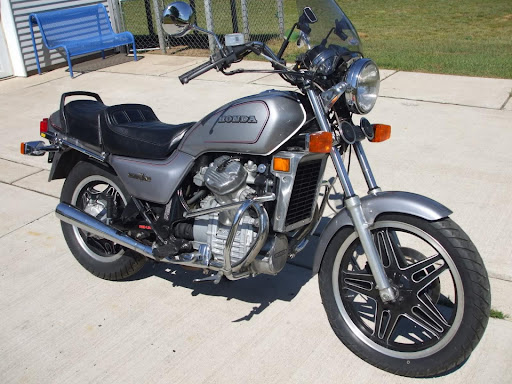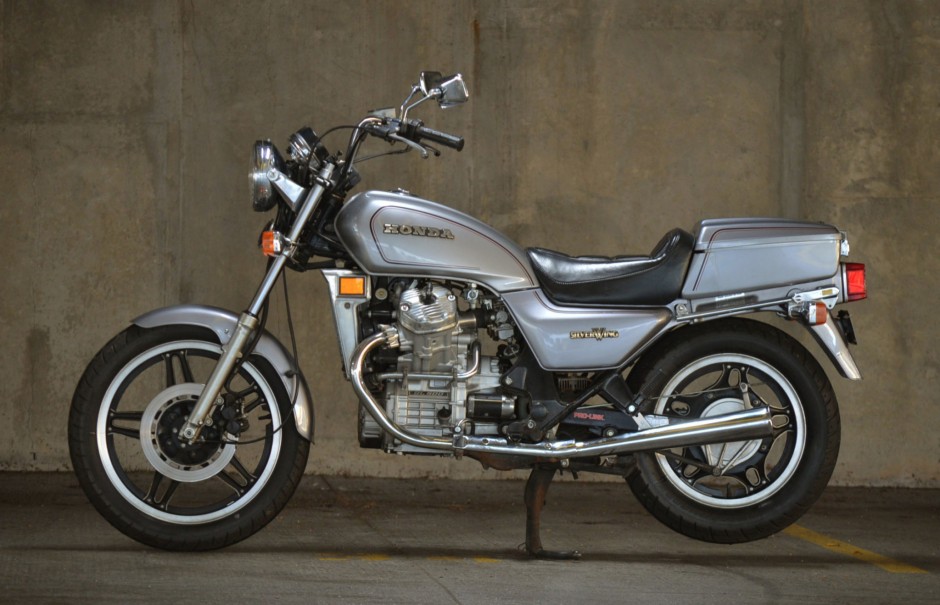Honda GL500 Silver Wing | Vintage Motorcycle Tales
The Honda GL 500 Silver Wing is a spin-off from another bike in the Honda lineup — the CX 500, which had been introduced in 1978. The Silver Wing – and its more lavishly equipped partner the Silver Wing Interstate – were introduced in 1981.
When a friend bought a new CX-500 in 1978, I was certain the model would die on the vine. I was even more skeptical about the GL-500 Silver Wing.
I thought, who needs liquid cooling, shaft drive and air adjustable suspension front and rear? Who needs interchangeable seats and travel trunks? Who wants that goofy looking engine with cylinders popping out the sides of the bike making it look like a low-budget Moto-Guzzi? Who wants that prominent radiator hung out there on the front?
As it turned out, lots and lots of people wanted those things, including me – about 20 years later. I admit it, when it comes to such technical innovations, I can be pretty slow on the uptake.
I owned my 1982 GL 500 Silver Wing for about three years, only selling it to make room for a 1984 Honda V30 Magna. Purchased from a private party, the GL-500 was preserved in pretty good order, overall.
Even after 23 years and more than 22,000 miles everything worked; and that’s saying something considering how much of everything there is with this bike. The technical derring-do Honda exhibited in the bike’s design is impressive.

As with most motorcycles, the engine tends to be one of the most prominent features. The GL 500’s engine was an attention-getter.
It is a liquid-cooled, 80-degree pushrod V-twin, with four valves per cylinder, displacing 497cc. Unlike some liquid cooled engines that are disguised to appear to be air cooled with bolt-on cooling fins, the GL 500 engine made no such pretense. The engine’s skin is the smooth exterior of its water jacket, with only a few minor ribs cast in on the rocker covers and lower crankcase.
The engine’s transverse orientation in the frame placed the cylinders protruding from the sides of the bike. This arrangement has obvious advantages for an air-cooled Moto Guzzi engine; it places the cylinders and heads out into the air stream for maximum cooling effect. For a liquid cooled engine where that air flow doesn’t matter, it creates a rather odd, lumpy appearance.
Adding to the oddness of the engine’s appearance, the cylinder heads were rotated 22 degrees from the axis of the crankshaft. This was done to create a straighter tract between the intake valves and the 34 mm Keihin constant velocity carburetors.
While this improved engine aspiration and performance, Honda made no attempt to conceal the design and as a result, it creates the appearance that the rocker covers were put on the engine askew.
For those of us brought up on vertical twins with nice, symmetrical barrels wrapped in cooling fins, all these angles, rotations and finless surfaces are a little radical. This set-up took some getting used to, but once done, it was easy to not only tolerate it, but to appreciate its surprising power and efficiency.
It’s even possible to get used to the torque reaction pulling the bike ever so slightly to the right when cracking the throttle at a stop sign.
The GL-500 has an exceptionally light clutch that’s a joy to use on day-long rides. Power reaches the rear tire via a low maintenance drive shaft. The five-speed transmission is an easy-to-use, positive shifting thing that in my mind could have been improved in only one way—the addition of a sixth speed.
The engine’s excellent torque and willingness to rev has the rider constantly reaching for the clutch for one more upshift after fifth gear. The engine spins at about 5500 RPM at 60 MPH in fifth gear, making it seem to work harder than it should have to.
A six-speed overdrive arrangement would have given the Silver Wing a much more relaxed tone on the open road, and perhaps less vibration in the mirrors. This design might have caused an occasional downshift on long or steeper inclines, but for most flat highway work, it would have been an improvement. A sixth ratio may also have increased the bike’s already impressive fuel economy—routinely 55 MPG on the highway.
The GL 500’s instruments and rider controls are all first rate. Large dial faces on the tachometer and speedometer are easy to read. An engine coolant temperature gauge is built into the lower edge of the tachometer and a trip mileage meter is included in the speedo.
Large, easy-to-see indicator lights are carried in a separate panel between the gauges. The ignition switch, choke and front fork air valve are all up there in the cluster, as well. Even the fuses are up on the steering head beneath a flat black cover panel over the handle bar.
The seat is deep and comfortable. The pegs and bars work together to create a fairly relaxed riding position for someone about my height—5’5.”
The bars are surprisingly wide — nearly 30 inches from end to end. They give the S-Wing the feel of a much larger motorcycle—and fairly slow handling. Which is not to say the S-Wing doesn’t handle well; it does.
But if the forks and Pro-link monoshock rear suspension are each aired up for a posh ride, it has the somewhat ponderous feel of an Electra-Glide in the corners – a strange feel for a bike that weighs about half what a Glide does. Pump in a little more air on both ends, and the ride gets harsher, but the handling still seems slow.
The double-piston disc brake up front generates just about as much braking force as you need on demand. Squeezing the lever gradually brings on gradual deceleration; pull hard, stop hard. The rear drum brake has a similar responsive feel to it, making it possible to stop the S-wing very hard in a straight line.
The interchangeable pillion seat and travel trunk make the bike more versatile in a way, as long as one has the option to pick between the added carry-along capacity of the trunk or taking a passenger; but you can’t do both. That’s why I added a set of leather day-trip size saddle bags.
Making the switch from the two-up seat to the travel trunk is amazingly easy. Just unlock the twin helmet locks at each side of the rear of the bike, pull up the chrome levers until the latches release and lift off the seat. Then, position the trunk and push down until the latches audibly click into position, push down the levers to lock and it’s done.
One of the few things that time has seemed to take a toll on is the plastic from which the rear cowling is molded on the detachable seat. It had developed stress cracks over the years and become nearly as brittle as glass, with one section of the cowling breaking off entirely.
Repairs with thin semi-rigid plastic sheet bonded to the reverse side and adhesive along the fractures were successful, but the seat section must be handled with care when mounting it to the bike.
The GL-500 wasn’t much of a pavement projectile when it was introduced and its position in the performance hierarchy of 30 cubic inch displacement bikes didn’t improve over the years. But, Honda didn’t design the bike for pulse-pounding, wheelie-pulling acceleration and top-end speed.
Over the years, the machines have proven themselves capable of accomplishing what Honda did intend them to: reliable, practical, long-term service in the mid-range touring and leisure riding class. In the U.K., many of these bikes are still in service as courier bikes and have astronomical mileage totals on them.
Its engine and drive-train combined some radical elements in terms of the transverse, finless, four valves-per-cylinder, V-twin engine with practical, proven elements like the age-old pushrod valve train.
Air-adjustable front and rear monoshock suspension was rather radical at the time for a 500 cc machine but the bike’s rake, trail and wide bars gave it a practical, well-mannered feel out on the road. Shaft drive added practicality for long, long highway miles with minimal maintenance.
Practically radical? Radically practical? Either way, the Silver Wing is destined to be remembered as one of Honda’s most innovative mid-sized road bikes.
Source ultimatemotorcycling.com

